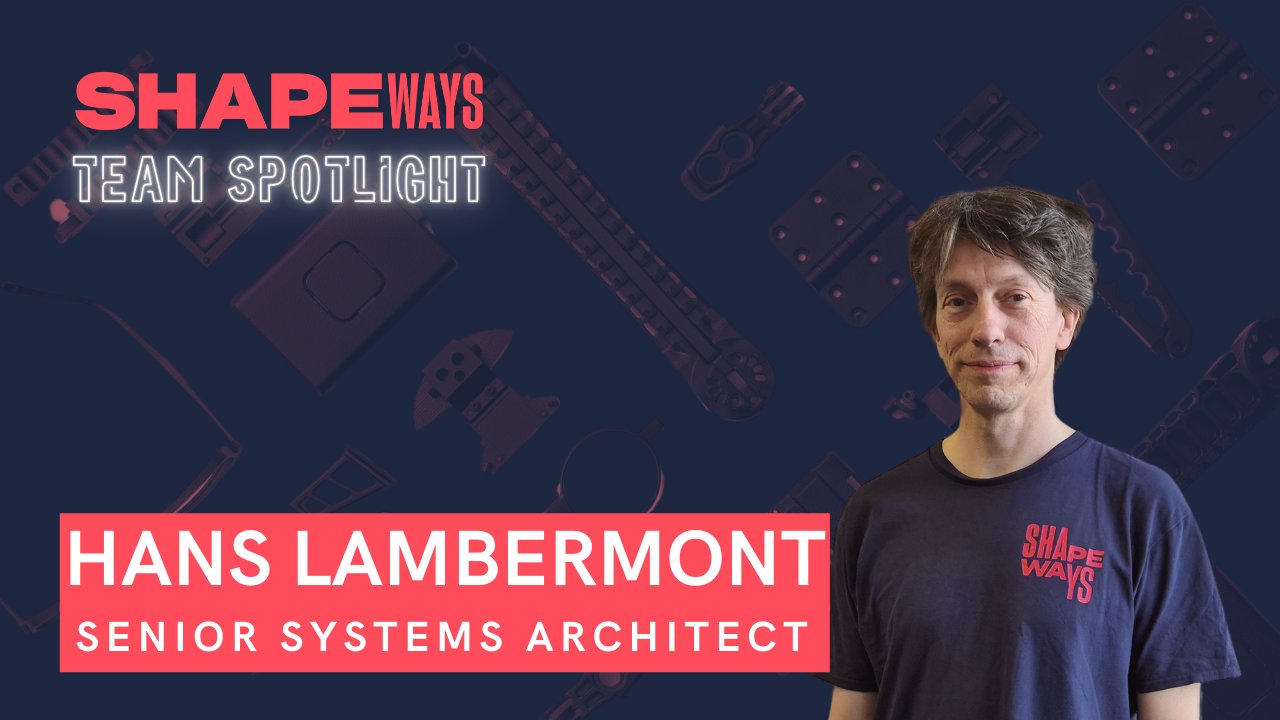One of the many recurring characters in television series is the company ‘lifer’. A long-term employee who gets comfortable with the status quo. They do their job on autopilot, embrace the routine and coast through until they retire. Hans Lambermont, our Senior Systems Architect, could not be further from that cliché — what has kept him at Shapeways for over 15 years isn’t routine, it’s evolution.
“For the various years I’ve worked here, a lot has changed over time, which is what basically has kept me here,” he says. “From startup to grow-up, moving offices, building teams in the US, migrating infrastructure through six different data centers, moving to the cloud, then moving out again. I like that. I like change.”

The invisible hand
As Senior Systems Architect, Hans is responsible for the infrastructure that keeps everything running. This can be something of a thankless task, because when you’re as good as Hans is, nobody notices your work. “Infrastructure is something that is typically not seen at all. It’s only visible once it breaks. But when it does break, everything that depends on it just stops. So you have to plan like everything that can break will break.”
It’s not just about patching up problems but more about building resilience. “If I have multiple servers that can do exactly the same thing, and one of them breaks, the other one should be able to take the full load. That’s good. Nobody notices anything even broke. That is a win.”
Hans’ decades of experience show themselves in subtle ways. “We’ve had fiber cuts to the buildings several times. So now, when I see construction happening near where the fiber cables lie, I get anxious… I’ve seen it happen. But that’s why we have failover plans, backup lines, routing protocols. You have to be ready.”
Readiness and resilience
That long-term thinking is vital now more than ever. Hans played a crucial role in the restart of Shapeways at the end of 2024, balancing the complex technical infrastructure with cost-efficiency and growth in mind. “We needed to reconfigure our cloud offering, moving more in-house but retaining the uptime and stability everyone expects. That was a successful project and that’s what we’re running on today.”
Complexity is sometimes inevitable, but where possible Hans prefers the minimalist approach. “When you’re developing systems that cater to multiple different requirements, you end up adding layers upon layers of complexity very quickly,” he explains. “And then, if there’s a problem, it’s very difficult to find where it resides. So I ask, ‘is that layer really needed’? Cutting complexity makes it easier to diagnose and fix problems — and to prevent them from happening again.”
And as Shapeways looks to scale, Hans’ role becomes even more central. “We’re currently harmonizing the infrastructure across the different parts of the business; scaling-up when needed, scaling back when we don’t. That saves cost but maintains resilience.”

Failing to prepare means preparing to fail
“You always need to plan for growth. If you can handle your current load, can you handle double that? Ten times that? With every scaling step, you need different solutions and it can get costly quickly. It’s a challenge to find the balance of resilience and cost viability.”
Perfection is always just over the horizon, but over time you can get pretty close to it. Hans’ experience in The Netherlands has given him an education in how to do things properly. “Shapeways’ factory in Eindhoven was the gold standard in terms of operations. In the early years, people from the company’s other sites would come here to learn how we do things.”
That stability, backed by technical maturity, is what underpins the company’s future. “Technical reliability often can’t be seen. It’s work that happens behind the scenes. But the people here — the team, the tools, the practices — are solid.”
Curiosity and cosmology
Perhaps unsurprisingly, Hans’ passion for the big picture — literally— doesn’t stop when he goes home. He’s written custom Linux drivers for his astrophotography hobby, built his own weather station and automated an observatory roof that opens and closes based on cloud cover. “It’s a fun challenge. I’ve been running it for a while now. Some objects are just two small dots in a star field, but if you know what you’re looking at, like a gravitationally split quasar, it’s fascinating.”
So what kind of person is best suited to the herculean task of keeping systems up and stopping problems before they happen?
“Curious people. People who are determined to fix something up to their own standards. Everything we run runs on Linux. We’ve used cutting-edge infrastructure: ZFS on Linux, EBGP routing, Kubernetes, Flux, Terraform… we’re not afraid to change. Change is constant. Expect it.”
And what makes a great day for Hans?“A good day is if I found the cause of an issue and was able to fix it, or if I saw that some preventative measure actually prevented a bigger problem from happening. That is nice.” You can follow along with the Shapeways Team Spotlight series to find out more about the team behind the scenes.


